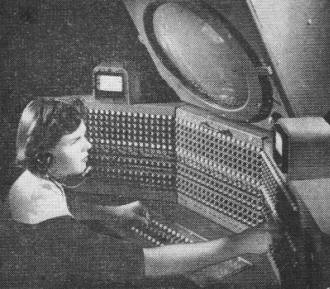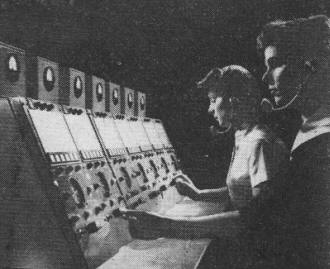Radar Tames the Wild Blue Yonder
|
|
The VOLSCAN (Volume Scanning) radar system was a paradigm changer for air traffic controllers charges with guiding aircraft while assuring safe separation. Busy terminal areas were a particularly difficult challenge due to the large variation in aircraft speeds and types. VOLSCAN was a computer that tracked the position, direction, and speed of each target and even made recommendations to controllers for course assignments. It also warned of impending dangerous scenarios. Another VOLSCAN article in the July 1954 issue of Radio-Electronics magazine went into more detail and had color photos of the equipment. Interestingly, the equivalent of maybe the world's first light pen computer interface is used by the operator for letting the processor know what part of the screen (PPI, or plan position indicator) he is referring to. Here is an IEEE Xplore article on VOLSCAN. Radar Tames the Wild Blue Yonder The sky, once empty and beyond reach, is now a busy thoroughfare. Aviation has shrunk space aloft as well as on the ground. With the planes themselves made safe by today's superb engineering, congestion of the air has become the chief risk of flying. As the wild, blue yonder grows wilder and more dangerous with fast planes crowding each other for space, the future of flying now depends on electronic aids to air safety. Volscan, developed jointly by the Cambridge Research Center of the Air Force and the Crosley Corporation, is the latest answer to the urgent problem of air traffic control in the vicinity of busy airports. Combining ordinary radar data, Volscan converts a cloud of randomly arriving aircraft into an orderly, safe procession. Giant overhead radar scope displays total air traffic situation. As newly arriving plane enters the monitored air space, an electronic computer coordinates its position and progress with every other plane in the area. Operators relay instructions to incoming aircraft in terms of azimuth and elevation. A supersonic jet plane may require as much as 50 miles for its landing approach, with some elbow room at either side. Therefore, an air traffic control system must assign each incoming aircraft a long "block of space" reserved exclusively for its use. Volscan automatically marks this space and follows the aircraft on its assigned path until the Instrument Landing System (ILS) takes over and sets it down on the runway. Since pilots can't just step on the brake and slow down, the problem is complicated by faster planes overtaking the slower ones. A fast plane coming in later might wind up right on top of a slower plane that had already started its landing approach. Hence, not only the sequence of the incoming aircraft but also their speeds must be taken into account. This adds to the space demand of fast planes and to the score of factors that every minute may tip the balance of life and death at a busy airport. Volscan keeps all these factors "in mind" at any moment, and automatically parcels out to each plane precisely the air space it needs to keep that fateful balance firmly held down on the safe side. As the airport radar sweeps the sky, each plane in the area appears as a "blip" on the radar screen. The operator marks each newly appearing blip with a light gun, which triggers Volscan's electronic brain into action. The computer then "follows" the plane as the blip moves on the radar screen. Acting as an electronic traffic manager, the computer has stored within itself the correct answers to every possible landing approach situation that may arise. Since the computer has the answer before the problem actually comes up, it needs only a fraction of a second to pick the correct approach instruction - in effect, to assign a block of space. These instructions are then given to the pilot by radio, or fed directly into the airplane's automatic controls by data-link transmission. Always on guard against error, Volscan keeps its unblinking eye on up to 14 planes which it guides simultaneously. If either the human or the automatic pilot takes any plane off the assigned course, the computer immediately compensates for the mistake and issues new instructions for getting the plane back on its track and arrival schedule. It must "touch down" at just the right moment, for the 13 other planes are strung by the computer in a tight but safe landing sequence. The result is maximum use of the available runway facilities, increasing the safe traffic capacity of any airport almost three times. In this manner, Volscan can handle one landing every 30 seconds, thus reducing the dangerous practice of "stacking" airplanes waiting around an airport for an opportunity to land. Such stacking is discomforting in present-day planes, but for the jets of the not-distant future, it would be disastrous. For jets use almost three times as much fuel at approach altitude as they do at cruising altitude. While awaiting their landing clearance, they might exhaust their fuel reserve. Volscan and the whole problem of air traffic control point up those ironic twists by which history bedevils human effort. Fifty years ago, when Man first transformed himself into a creature of flight, the main idea was to get him off the ground. Now, in the headlong progress of the air age, he seems to have trouble in getting down again. But electronics offers him a safe ladder for his descent.
Posted April 18, 2022 (updated from original post on 6/30/2016) |
|



